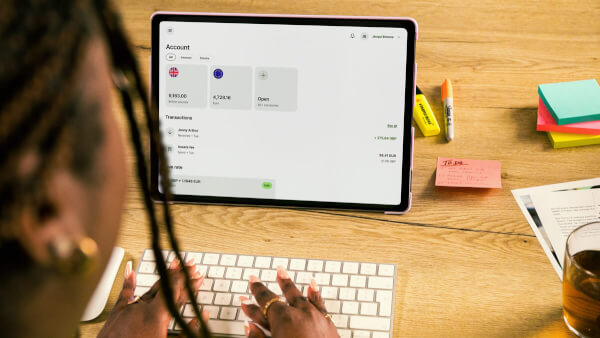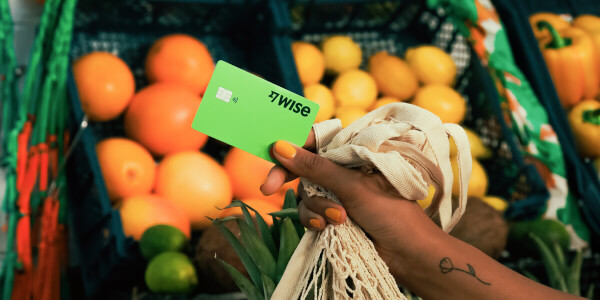Wise ACH vs wire guide
Everything you need to know about using Wise for USD transfers and paying via ACH vs wire

Chase Bank is one of the largest banks in the United States, and is one of the “Big Four” banks in the country. It has over 5,000 branches, as well as a network of around 16,000 ATMs. Its owned by the massive JPMorgan Chase & Co. company.¹
Given that scale, it’s not surprising that a lot of people use Chase’s services when they travel overseas. One of the most common products they use is the Chase Slate credit card. It’s simple to use, and as it carries the Visa brand it’ll be accepted almost everywhere, but whenever you travel abroad there are some catches to watch out for.
Read on and we’ll talk about what the Chase Slate card offers, and what happens when you use it in another country. That includes:
This card carries a charge of 3% on all foreign transactions.² That applies every time you use it abroad, you’ll have 3% added to your bill. You’ll need to pay this when you withdraw cash from an ATM, as well as when you buy something from an overseas seller. This is a flat percentage rate — there’s no minimum charge to hit you on small transactions.
Like most credit cards, the Chase Slate card carries fees for some other stuff as well as foreign transactions. A big piece of good news is that there’s no annual fee to worry about. The card also doesn’t increase your Annual Percentage Rate (APR) level for late payments, and you can get free, unlimited access to your credit score whenever you need it.
If you want to transfer an existing balance to this card, it’s worth doing so in the first 60 days after you open the account. That way, you’ll avoid any fee for the service. Wait longer, and you’ll be hit for 5% of the transfer amount, and even for small transfers there’s a minimum fee of $5. Interest on transfers and purchases is waived for the first 15 months with Chase Slate. After that, the APR will vary — when we checked, the range was given as between 17.24% and 25.99%.
There are a couple of handy benefits you get with this card. Chase’s Real-Time Fraud Monitoring system, plus their included cover of up to $500 a day should help put your mind at rest. You’ll also get a contactless card — that means you can just tap to pay, much quicker than traditional swiping and signing. On the downside, there’s no rewards program and no cash back, so this may not be the ideal card if you’re looking for that little lift.³
The Chase Slate credit card has a pretty simple fee structure, but there are a few other fees that could hit you. If you want a cash advance, that’ll cost you either $10 or 5% of the amount — whichever is higher. Late or returned payments carry a flat-rate fee of $38, though there’s nothing to pay on returned checks, or if you go over your credit limit.⁴
When you’re traveling overseas, you won’t always get the same value with your transactions. Part of that is because banks may charge upfront fees, but okay, you can see that pretty clearly. The other reason is that the exchange rate you get won’t always be the same, and this isn’t so easy to notice if you don’t know what to look for. That’s a problem, because it’s easy to think everything’s great until your card account summary turns up.
The actual rate you’ll get is something your bank decides, so it won’t always be the same. It’s very unlikely to be the rate you see when you search for exchange rates on Google. That’s because banks usually add a markup — it’s not called a fee, but it has a pretty similar effect on your bill. That means you can end up losing out, even if the card you’re using is a pretty good deal otherwise.
Something you need to know about here is the mid-market rate. We talked about Google a minute ago and the exchange rate you’ll see there is the mid-market rate. This is what banks use themselves when they buy and sell currency. As its name suggests, it’s the midpoint between the buy and sell rates. It’d be great if this rate was the one banks charged, but that markup charged by whoever’s handling the rate conversion means it probably won’t be. That could be your card issuer or the ATM company.
If this doesn’t sound like what you want, then it could be time to look into an alternative to a conventional bank account. Now, there’s the Wise borderless account. This new way to pay and get paid lets you work in over 40 currencies, and you get that juicy mid-market rate. There’s a single, low, upfront fee to pay — and that’s it. You can also get the Wise multi-currency debit card, which you can use to pay for goods and services all over the world.
As a savvy traveler, you’ll want to get the best value possible when you use your credit card in another country. Something that can look a great deal is when you’re offered the chance to work in your own currency instead of the local one. This happens pretty often when you make a purchase abroad or use an overseas ATM. It’s called Dynamic Currency Conversion (DCC) — but you know what? It’s not the great deal it seems.
Let’s see why that is. The big red flag is that you’re likely going to be hit for a bigger bill than if you stick to local currency. This is because the seller or ATM operator gets to set the exchange rate — and as we saw before, that’s usually not good news. If you’d like to know more about the ins and outs of DCC, including step-by-step examples, head over to our article on DCC. The really important point though is: always, and we really do mean always, choose to use local currency at foreign ATMs. You won’t regret it.
To sum up, the Chase Slate credit card offers some pretty nice features for overseas travelers. There’s no annual fee, for a start. It’s also contactless and in many countries such as the UK and Australia, contactless payments are now the norm. On the downside, this card’s foreign transaction fee means you’ll pay more than you want every time you make a purchase or use a foreign ATM. If you’re not too keen on that, then it may be worth taking a look at alternatives like the Wise borderless account and the linked debit card.
Sources:
All sources last checked 1 April 2019
*Please see terms of use and product availability for your region or visit Wise fees and pricing for the most up to date pricing and fee information.
This publication is provided for general information purposes and does not constitute legal, tax or other professional advice from Wise Payments Limited or its subsidiaries and its affiliates, and it is not intended as a substitute for obtaining advice from a financial advisor or any other professional.
We make no representations, warranties or guarantees, whether expressed or implied, that the content in the publication is accurate, complete or up to date.

Everything you need to know about using Wise for USD transfers and paying via ACH vs wire

Learn all about how the Wise card compares to no FTF ones.

Can you use a Wise Account to convert money you earn?

See how the Wise card compares with Chase Sapphire in our complete guide

Discover in detail whether your account information is visible to the recipient when you make a payment through Wise.

Not sure if Instarem or Wise is the best option for you in the US? Check our guide and find out.